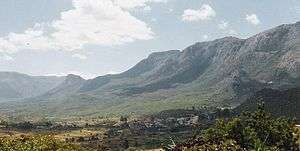Eastern Highlands
- "Eastern Highlands" also refers to Eastern Highlands Province in Papua New Guinea, and part of the Great Dividing Range, Australia.

The Eastern or 'East African Highlands' is a mountain range in the east of Zimbabwe and one of four distinct physiographic divisions on the African continent. It extends for about 300 kilometres (190 mi) along Zimbabwe's eastern border with Mozambique.[1]
The range comprises three main mountain groups - Nyanga (to the north) which contains Zimbabwe's highest mountain Mount Nyangani, Africa's second-longest waterfall Mutarazi Falls and the Honde Valley which leads into Mozambique; Bvumba Mountains (centrally situated near the city of Mutare); and Chimanimani (to the south). These regions are all sparsely populated, highland country and are covered in rich grassland and forests.[1]
The Highlands have a more equable climate than Zimbabwe's central plateau, with higher rainfall, low cloud and heavy mists and dew as moisture moves inland from the Indian Ocean. Many streams and rivers originate in these mountains, which form the watershed between the Zambezi and Save River systems.
The East African Highlands physiographic division consists of the East African Rift and Abyssinian physiographic provinces, so are part of the long chain of mountains that runs down East Africa and share much common plant and animal habitats with other mountain areas in the east of the continent.
Flora
Much of the small area consists of rolling hills covered with grassland, which are renewed annually following the fires that occur at the end of the dry season. Some valleys and east-facing slopes contain areas of tropical rainforest, with a high canopy, lianas, and a rich undergrowth. There are larger areas of dry forest at higher altitudes in places where the ground is well watered and on drier slopes patches of miombo woodland (Brachystegia spiciformis, Brachystegia tamarindoides and Uapaca kirkiana) and areas of heathland at higher elevations. There are patches of the tall evergreen Mobola Plum Parinari curatellifolia near the town of Chipinge and on the western slopes of the Nyanga Highlands. A number of indigenous monocot lilies with small distribution ranges occur in these mountains Cryptostephanotis vansonii, Cyrtanthus rhodesianus, Scadoxus pole-evansi to name a few (popular with rare plant collectors)
Fauna
This variety of different types of habitat results in a richness of animal life too. Animals found in the Highlands include blue monkey (Cercopithecus mitis) the Samango Sykes' monkey, East African little collared fruit bat (Myonycteris relicta) and Marshall's pygmy chameleon (Rhampholeon marshalli). Many of these animals are found throughout East Africa.[2]
The highlands are also rich in birdlife[3] including trumpeter hornbill (Bycanistes bucinator), Knysna turaco (Tauraco corythaix), purple-crested turaco (Tauraco porphyreolophus), crested guineafowl (Guttera pucherani) and crowned eagle (Stephanoaetus coronatus). The forests are also full of butterflies, most notably swallowtails such as the emperor swallowtail (Papilio ophidicephalus) and the citrus swallowtail (Papilio demodocus) and the forest undergrowth in particular shelters a variety of reptiles including skinks, geckos, lizards, frogs, toads, and snakes.
Threats and preservation
The mountain forests are vulnerable to logging and the grasslands susceptible to fire and the rainforests, which by definition grow on well-watered fertile land, to clearance for agriculture. The moist climate is ideal for planting tea, coffee and hardwoods. However, much of the original vegetation remains, especially at higher altitudes, which are not suitable for farming. Large areas of the Highlands are protected, including the 171km2 Chimanimani National Park and Nyanga National Park.
References
Coordinates: 18°43′23″S 32°50′31″E / 18.723°S 32.842°E